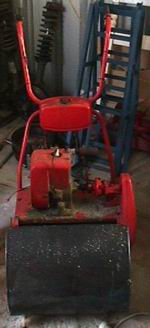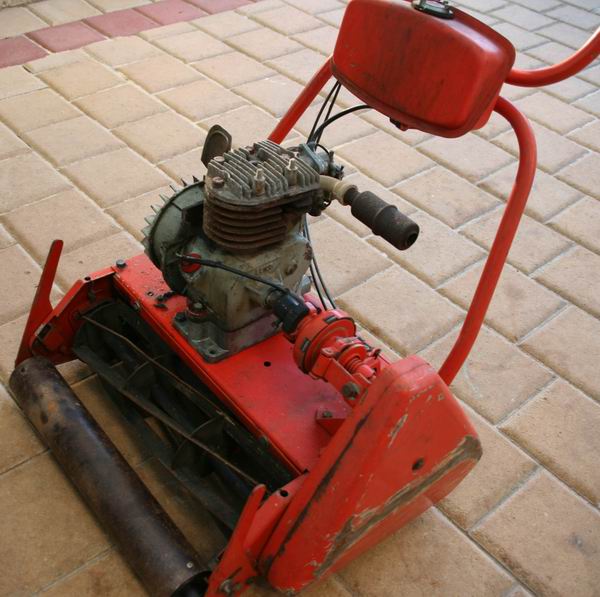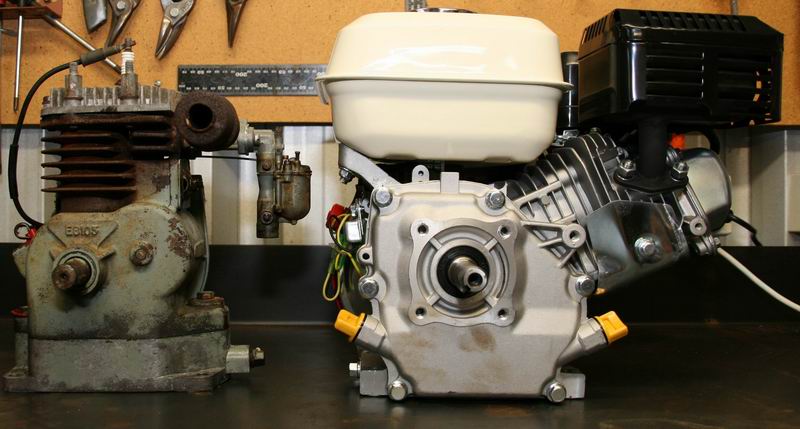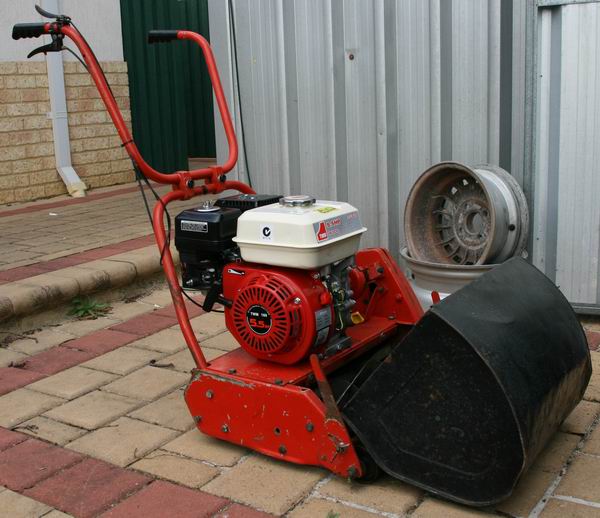In 1995, or maybe it was 1996, I decided that I needed to be able to mow my own lawn. This was partly because it was costing too much money paying the mowerman, there were weeds being introduced carried in by seeds on the mowermans mower, but mostly because mowers have petrol engines on them and are therefore blokey.
A quick look in the local paper revealed a few secondhand reel mowers for reasonable prices. I could have gone a rotary mower, much cheaper, but there is no cut like the cut from a reel - you won't get a bowling green from a rotary mower.
There was one available just minutes down the road, so off I went. It was shiny and pretty, he gave me a demo and it cut just fine. I parted with $AUD300(1996) and threw it in the back of the car. I will never forget his face when I dropped the boot lid down on it and scratched the paint on the handles. He was horrified. When I thought about it later I realised he had completely dismantled the thing, cleaned it up and painted it, put it back together and got it running smoothly. It must have been a passion for him, restoring old mowers. And here I was "Na worries, she'll do the job just fine thanks mate" slap it in the boot and head off with my new workhorse not a showpony.
It is an Atco mower, British made. I wouldn't even like to guess at the year of manufacture, let's just say it is old. For years it cut the lawn just fine. The motor was always a bit smokey and it used a lot of oil, but it never failed me. By about the 5th year it was starting to get sad and I was sure it would die pretty much every time I used it. But years went by and it just kept going and going. Bits started falling off and not working properly, I had to replace a couple of bearings in the body and disconnect the auto drive mechanism, but it always cut the lawn.
One of the "interesting" modifications I made early on was the "electric start". This happened because it was always hard to start (being a bit smokey/oily) and the starter broke from too much hard pulling. In frustration I ripped the starter off and welded a short length of rod to the right sized socket, and spun it up with a drill until the engine took and away it went. I went through at least one drill starting the mower for the 7 years it was "electric start" ;)
I also occasionally sharpened the blades myself. Okay if you work in OH&S skip the rest of this paragraph. Basically chock the mower up, running, rotating blade spinning and with a sanding pad on your angle grinder running back and forth over the rotating blade until it is all shiny. Stop the mower and do a quick pass along the fixed blade as well. The object is to turn the worn curved surface back into a flat 90 degree edged surface. To get a good scissor action. Wind down the rotating blade while it is running until the motor is about to stall, back it off a quarter turn, you are ready to go.
You can do this a few times before it isn't enough anymore. At that stage, with the mower stopped, run the grinder along each section of the rotating blade to cut back the trailing edge, ie, so it is like scissors. If the trailing edge is higher than the leading edge, well it is going to rip and tear at the grass not scissor cut it cleanly. Once you've done that, go back to the spinning sharpening technique from before. It will help smooth out any bumps you've created. Spray a bit of paint while it is running first, run the grinder across the rotating blade, stop the mower and see where there is still paint left. That represents the low spots. Repeat until all paint is gone.
Anyway, there's a point to this story, and it starts now.
After around 12 years of use, the engine finally died. There was a bang/clunk during operation and it conked out and refused to restart. Pulling the plug showed shiny metal flakes floating around inside. Hmm, pretty terminal. Probably dropped a valve or something.
There were two options I could see: (a) buy a new mower, around $2000. (b) buy a new motor. I decided I needed a bit of motor fun so I researched (b).
On ebay I found a guy selling stationary engines in Australia, lets call them "Chondas", i.e. Chinese copy of Hondas. Now I've got a lot of respect for the up and coming Chinese gear - sure, in the 90's the best they were doing was plastic toys for McDonalds happy meals but they've come a long way. I was prepared to trust them.
A few emails with the seller showed me that the bolt up pattern, the output shaft size, the positioning of the Chonda was pretty much exactly the same as the existing motor. I settled on the 5.5 horsepower from the range, because it essentially looked like it would bolt straight up, but also because it was probably 3 times more powerful than the existing motor. Og og og.
So just under $AUD300(2008) and a week later it arrived. All looked good, the only issue I could see was the output shaft was a bit too long. A rough and ready placement revealed if I cut about 25mm off the shaft it would be perfect. That included the exhaust and intake fitting nicely between the handles out the back. I must say it took me about a week before I had the guts to take a hacksaw to a brand new motor, but eventually I did and cut 25mm off the shaft ;)
There were a couple of other niggly problems with the mower; for one thing the clutch pivot/guide wear plates were ground to nothing and the lever had gone metal on metal with the clutch. The original plates were bakelite or some other carcenogenic substance, I once replaced them with plastic which lasted about 2 mows, this time I went with aluminium. So far so good.
The other problem was one of the engine mounting bolts was missing, and one was stripped. Since this is an old British mower it is all Whitworth threads. Not going to find them in a hurry. So I cold chiseled the captured nuts off the mounting plate and welded some metric nuts on.
Threw the motor on & coupled it to the drive, put in some oil and fuel, two pulls on the starter later blub-blub-blub-blub; perfect!
I didn't bother connecting the hand throttle to the new mower. As you can see the motor is self contained - integral fuel tank, on/off switch, throttle control - so all the old stuff is no longer required.
I wound the throttle up just off idle, engaged the blades and went mowing. Even just off idle, with the blades set to scalp the lawn, it didn't load up the mower at all. Engine is overpowered, as expected. Glad I didn't go with the 9hp version ;)
I decided running the motor at idle for its whole life probably isn't good for it, so I figured when running go for about 1/4 power just to give it something to do.
So all in all, a good project, straight forward and excellent result. Not to mention extra points for the "big block" overpowered motor sitting on top; it looks like a V8 jammed into a Mini!













 database
database